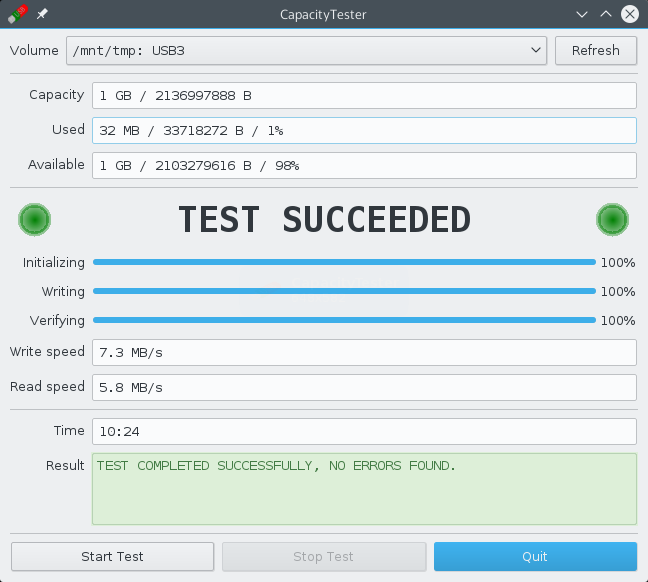This tool can test a USB drive or memory card to find out if it's a fake. For example, a fake might be sold as "64 GB USB thumbdrive" but it would only have a real capacity of 4 GB, everything beyond this limit will be lost. Write requests beyond that limit might be ignored without error, so a user would not be notified about the data loss.
This tool performs a simple test to determine if the full capacity is usable or not. All it does is fill the volume with test data and verify if the data on the volume is correct.
The volume must be completely empty for the test to provide reliable results.
Only mounted filesystems show up in the list, so you have to mount your USB drive before you can test it. You could use a file manager like Caja for that.
Although the test is non-destructive (i.e., it won't touch existing files), you should make sure to remove any existing files from the drive.
During the initialization phase of the test, temporary test files are created. If the drive is defective and reports errors, the test should abort at this stage. After the initialization phase, a test pattern is written to the drive, which is then read back and verified. During the test, the drive will be completely filled up. If you have a fake drive, the test would fail when test data written beyond the real capacity limit is read back. The test should also fail if a genuine drive has become defective.
After the test has finished, the temporary files are deleted automatically. However, if the drive is removed or dies during the test, the files will have to be deleted manually by the user.
The program does not detect and report the type of fake, it just reports an error and where the error has occurred. This may or may not provide an estimate on the real capacity of the drive, but no guarantees are made regarding the accuracy of the result.
A volume test works with files on top of the filesystem of the drive, so it does not know where each file ends up on the drive. It depends on the filesystem where each test file is written and how it may be fragmented. This means that the reported offset in case of an error is a file offset, not a physical offset and it might be much smaller than the real capacity of a fake drive.
Many complex filesystems do not allow the full capacity to be used as metadata and fragmentation can reduce the available capacity once files are written. For that reason, there is a buffer, which should be around 1 MB. Some filesystems such as FAT32 do not need a buffer (SAFETY_BUFFER = 0).
This software requires Qt 5.
Build using qmake:
$ qmake
$ make
Cleanup:
$ make distclean
Build without qmake (alternative): Make sure that the QTDIR environment variable points to your Qt build directory.
$ export QTDIR=~/Builds/Qt/5.5.1-GCC5.3.1-FEDORA22
$ cd build
$ make
Windows build:
$ SET QTDIR=...
$ cd build
$ make PLATFORM=win32-g++
32-bit build:
$ export QTDIR=... # 32-bit Qt build (-platform linux-g++-32)
$ cd build
$ make rebuild-32bit
Cleanup:
$ cd build
$ make clean
Use the libraries in your own Qt build directory if they're not installed. If you don't have the Qt 5 libraries installed but you have a custom Qt build:
$ LD_LIBRARY_PATH=~/Builds/Qt/5.5.1-GCC4.7.2-DEBIAN7/qtbase/lib \
bin/CapacityTester
Call with plugin directory explicitly set (e.g., if xcb plugin missing):
$ export QTDIR=~/Builds/Qt/5.5.1-GCC5.3.1-FEDORA22 \
LD_LIBRARY_PATH=$QTDIR/qtbase/lib \
QT_PLUGIN_PATH=$QTDIR/qtbase/plugins \
bin/CapacityTester
If the program still won't start because the xcb plugin can't be loaded, you're probably missing a library or two. Check the dependencies of $QTDIR/qtbase/plugins/platforms/libqxcb.so and install the missing libraries or add them manually.
Command line mode (no gui):
$ export LD_LIBRARY_PATH=~/Builds/Qt/5.5.1-GCC4.7.2-DEBIAN7/qtbase/lib
$ bin/CapacityTester -platform offscreen
$ bin/CapacityTester -platform offscreen -list
Philip Seeger ([email protected])
Please see the file called LICENSE.

